Small overlap front: driver-side
Rating applies to 2015-20 models
Tested vehicle: 2015 Nissan Pathfinder SV 4-door 4wd
The Nissan Pathfinder was redesigned for the 2013 model year, and the Infiniti JX35, a luxury version of the Pathfinder, was introduced in the 2013 model year. Beginning with 2014 models, the JX35 was renamed the QX60. Beginning with 2015 models of both the Pathfinder and QX60, the front-end structure was modified to improve occupant protection in small overlap frontal crashes.
| Evaluation criteria | Rating |
|---|---|
| Structure and safety cage | |
| Driver injury measures | |
| Head/neck | |
| Chest | |
| Hip/thigh | |
| Lower leg/foot | |
| Driver restraints and dummy kinematics | |
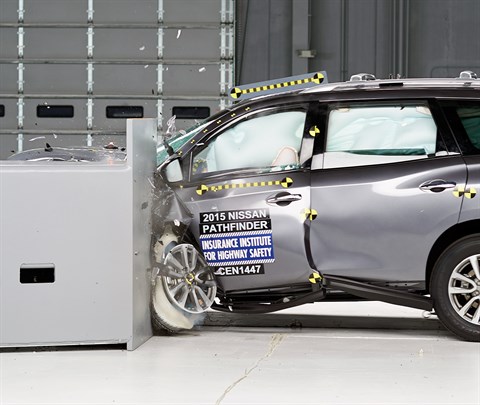
Action shot taken during the driver-side small overlap frontal crash test.

The dummy's position in relation to the door frame, steering wheel, and instrument panel after the crash test indicates that the driver's survival space was maintained well.

The frontal and side curtain airbags worked well together to keep the head from coming close to any stiff structure or outside objects that could cause injury.

The driver's space was maintained well, and risk of injuries to the dummy's legs and feet was low.
Small overlap front: passenger-side
Rating applies to 2015-20 models
Tested vehicle: 2018 Nissan Pathfinder S 4-door 4wd
The Nissan Pathfinder was redesigned for the 2013 model year, and the Infiniti JX35, a luxury version of the Pathfinder, was introduced in the 2013 model year. Beginning with 2014 models, the JX35 was renamed the QX60. Beginning with 2015 models of both the Pathfinder and QX60, the front-end structure was modified to improve occupant protection in small overlap frontal crashes.
| Evaluation criteria | Rating |
|---|---|
| Overall evaluation | |
| Structure and safety cage | |
| Passenger injury measures | |
| Head/neck | |
| Chest | |
| Hip/thigh | |
| Lower leg/foot | |
| Passenger restraints and dummy kinematics | |
| Driver injury measures | |
| Head/neck | |
| Chest | |
| Hip/thigh | |
| Lower leg/foot | |
| Driver restraints and dummy kinematics | |
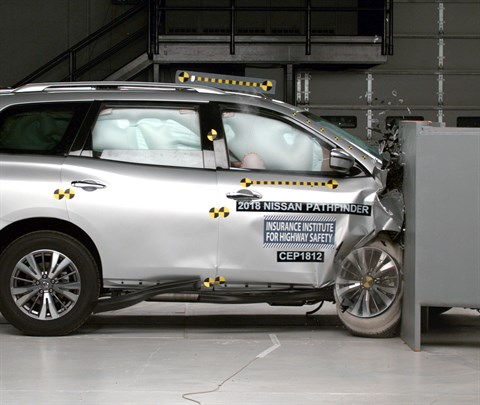
Action shot taken during the passenger-side small overlap frontal crash test.
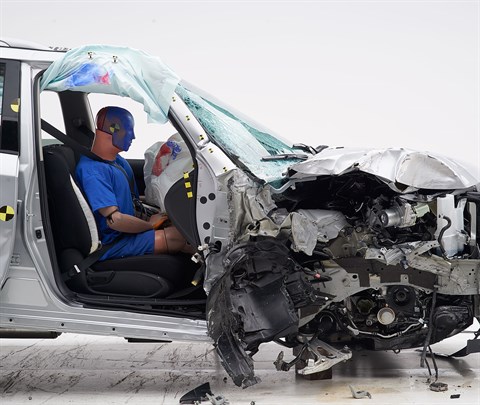
The dummy's position in relation to the door frame and dashboard after the crash test indicates that the passenger’s survival space was not maintained well.
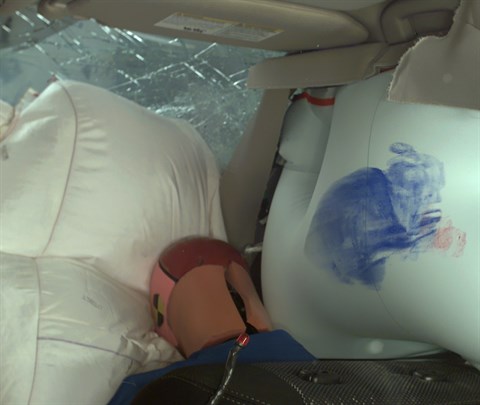
The frontal and side curtain airbags worked well together to keep the passenger dummy’s head from coming close to any stiff structure or outside objects that could cause injury.
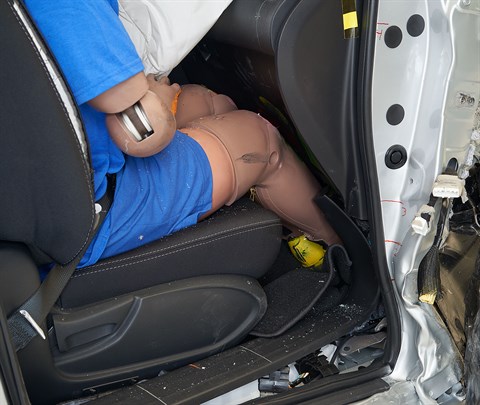
Despite intrusion of the door hinge pillar and dashboard, risk of injuries to the dummy's legs and feet was low.
Moderate overlap front: original test
Rating applies to 2013-20 models
Tested vehicle: 2014 Nissan Pathfinder Platinum 4-door 4wd
The Nissan Pathfinder was redesigned for the 2013 model year, and the Infiniti JX35, a luxury version of the Pathfinder, was introduced in the 2013 model year. Beginning with 2014 models, the JX35 was renamed the QX60.
Moderate overlap frontal ratings are assigned by the Institute based on two tests conducted by Nissan. The first test was conducted on a 2013 model Pathfinder and the second test on a 2014 model Pathfinder. Ratings apply to all Pathfinders beginning with the 2013 model year, the JX for the 2013 model year, and all QX models beginning with 2014.
| Evaluation criteria | Rating |
|---|---|
| Overall evaluation | |
| Structure and safety cage | |
| Driver injury measures | |
| Head/neck | |
| Chest | |
| Leg/foot, left | |
| Leg/foot, right | |
| Driver restraints and dummy kinematics | |
Side: original test
Rating applies to 2014-20 models
Tested vehicle: 2014 Nissan Pathfinder SV 4-door 4wd with standard head curtain airbags for all three rows of seats and standard front seat-mounted torso airbags
The Nissan Pathfinder was redesigned for the 2013 model year, and the Infiniti JX35, a luxury version of the Pathfinder, was introduced in the 2013 model year. Beginning with 2014 models, the JX35 was renamed the QX60, and both the Pathfinder and QX60 received side curtain airbag and rear door structural modifications to improve occupant protection in side impact crashes. Side ratings are assigned by the Institute based on a test conducted by Nissan.
| Evaluation criteria | Rating |
|---|---|
| Overall evaluation | |
| Structure and safety cage | |
| Driver injury measures | |
| Head/neck | |
| Torso | |
| Pelvis/leg | |
| Driver head protection | |
| Rear passenger injury measures | |
| Head/neck | |
| Torso | |
| Pelvis/leg | |
| Rear passenger head protection | |
Roof strength
Rating applies to 2015-20 models
Tested vehicle: 2015 Nissan Pathfinder SV 4-door 4wd
| Overall evaluation | |
|---|---|
| Curb weight | 4,431 lbs |
| Peak force | 20,719 lbs |
| Strength-to-weight ratio | 4.68 |
Head restraints & seats
Seat type: Power cloth seat
| Overall evaluation | |
|---|---|
| Dynamic rating | |
| Seat/head restraint geometry |
About the head restraint & seat test
Currently, IIHS tests apply only to front seats.
Child seat anchors
Rating applies to 2015-17 models
| Evaluation criteria | Rating |
|---|---|
| Overall evaluation | |
| Vehicle trim | SV |
| Seat type | cloth |
This vehicle has 2 rear seating positions with complete child seat attachment (LATCH) hardware.
It has 2 additional seating positions with a tether anchor only.
| Evaluation criteria | Rating |
|---|---|
| Overall evaluation | |
| Vehicle trim | SV |
| Seat type | cloth |
| Rating icon | Rating |
|---|---|
| G | Good |
| A | Acceptable |
| M | Marginal |
| P | Poor |
| Seating positions that rely on borrowed lower anchors or have only a tether anchor available are not rated. | |
thether anchor symbol | Tether anchor |
lower anchor symbol | Lower anchors |
| Lower anchor(s) can be borrowed from adjacent positions(s) | |
| No hardware available |
Details by seating position
| Position | Rating |
|---|---|
| 1 | |
| Tether anchor | |
| easy-to-find location | |
| no other hardware could be confused for anchor | |
| Lower anchors | |
| too deep in seat | |
| not too much force needed to attach | |
| easy to maneuver around anchors | |
| 2 | |
| Tether anchor | |
| easy-to-find location | |
| no other hardware could be confused for anchor | |
| Lower anchors | |
| none available | |
| 3 | |
| Tether anchor | |
| easy-to-find location | |
| no other hardware could be confused for anchor | |
| Lower anchors | |
| too deep in seat | |
| not too much force needed to attach | |
| easy to maneuver around anchors | |
| 4 | |
| Tether anchor | |
| easy-to-find location | |
| other hardware could be confused for anchor | |
| Lower anchors | |
| none available |
